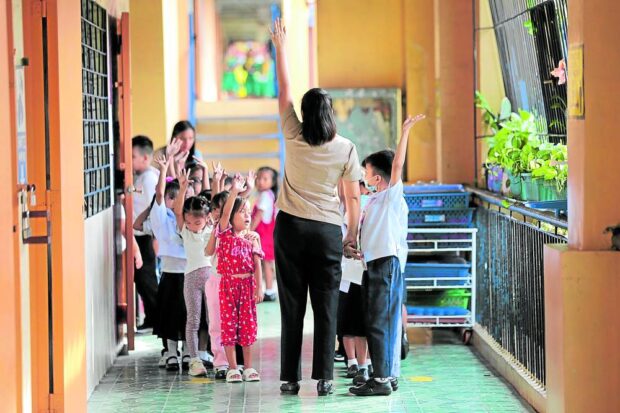
TOUGH JOB | Kindergarten teacher Jill Mary rounds up her pupils during the first day of classes in 2023. (FILE PHOTO)
MANILA, Philippines — Lack of government support for its workers and insufficient day care centers, now referred to as children development centers or CDCs, have hounded the country’s early education programs in the past years, with calls from an international organization to invest at least 10 percent of the education budget to early childhood education (ECE).
Findings by the Second Congressional Commission on Education (Edcom II) showed that becoming a teacher for ECE degree holders has “little appeal” for them due to low honorarium and lack of job security.
In its 398-page report, data gathered by the Edcom II from the Department of Social Welfare and Development revealed that 14,725 child development workers/teachers (CDW/Ts) are receiving only a monthly honorarium worth less than P1,000 from their respective local government.
This is a pittance compared to the average salary of P5,000 per month for nonpermanent daycare workers or teachers, while salaries for kindergarten teachers, as provided by the Department of Education, are “significantly higher” with a P27,000 monthly pay.
At the same time, the congressional body revealed that only 11 percent of child development teachers have permanent positions, with 89 percent of them having nonpermanent — and even voluntary — roles.
“Since child development workers rely on [local governments] for their monthly pay, their professional development is also subject to the support of their [local government’s] leadership,” the Edcom II report said.
Citing a 2019 study by the Unicef (United Nations International Children’s Emergency Fund) Philippines, there were only more than 50 percent of CDW/Ts who have undergone less than two training courses.
80 graduates per year
The Edcom II report also observed there were only 3,993 graduates specializing in early education degrees since 2005 and a mere 224 institutions have been providing such a degree, based on the data by the Commission on Higher Education (CHEd).
In hindsight, the said figures only equate to an average of approximately 80 graduates per year, the report added.
“Such figures fall significantly short of the demand for primary-school teachers alone,” it said.
Municipalities that are categorized with lower income levels are impacted by the shortage of early childhood development workers, the report pointed out.
The independent body also stressed that based on the “outdated” Teacher Professionalization Act of 1994, ECE graduates teaching children aged 0 to 4 would have to register for the elementary level exam for them to take the licensure exams.
“These practices stand in contrast to practices in other Southeast Asian countries,” the report said, citing Vietnam, wherein two years of ECE training already “suffice” to qualify those who want to teach in daycare centers.
The number of CDCs nationwide is not enough, especially in areas that are categorized as “economically disadvantaged.”
Only one or two CDCs can cater to every 10,000 children aged 3 to 4 in “sixth-class” municipalities, while first-class municipalities have as many as six CDCs.
Out of the 42,027 barangays, a total of 26,820 have no recorded CDCs, meaning that only 15,207 barangays from all over the country have at least one CDC, or just 36 percent of the number of barangays.
“The uneven distribution of CDCs prompts the need for a thorough investigation and intervention at the national level,” the Edcom II said.
Certificate programs
As a result of these findings, the commission recommended that CHEd and the Technical Skills Development Authority create “pathways” for child development workers by undertaking the development of certificate programs for them.
The report added plantilla positions should also be created for the child development workers and teachers that could enhance job security and professional stability among them.
As for the lack of CDCs, it added a universal database should be developed, which would consolidate the data pertaining to early childhood education, nutrition, and welfare interventions.